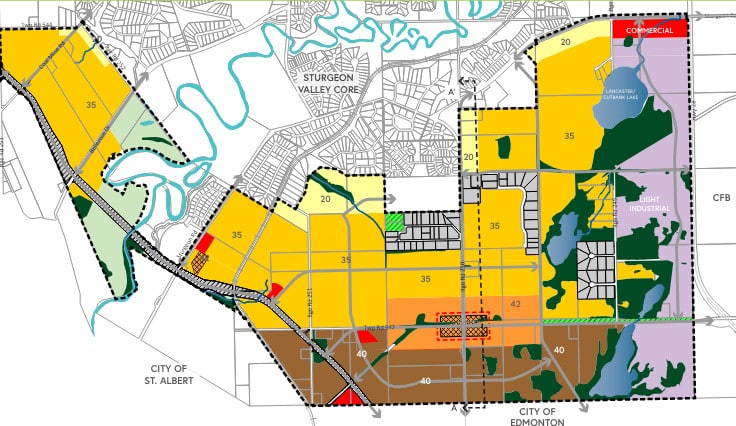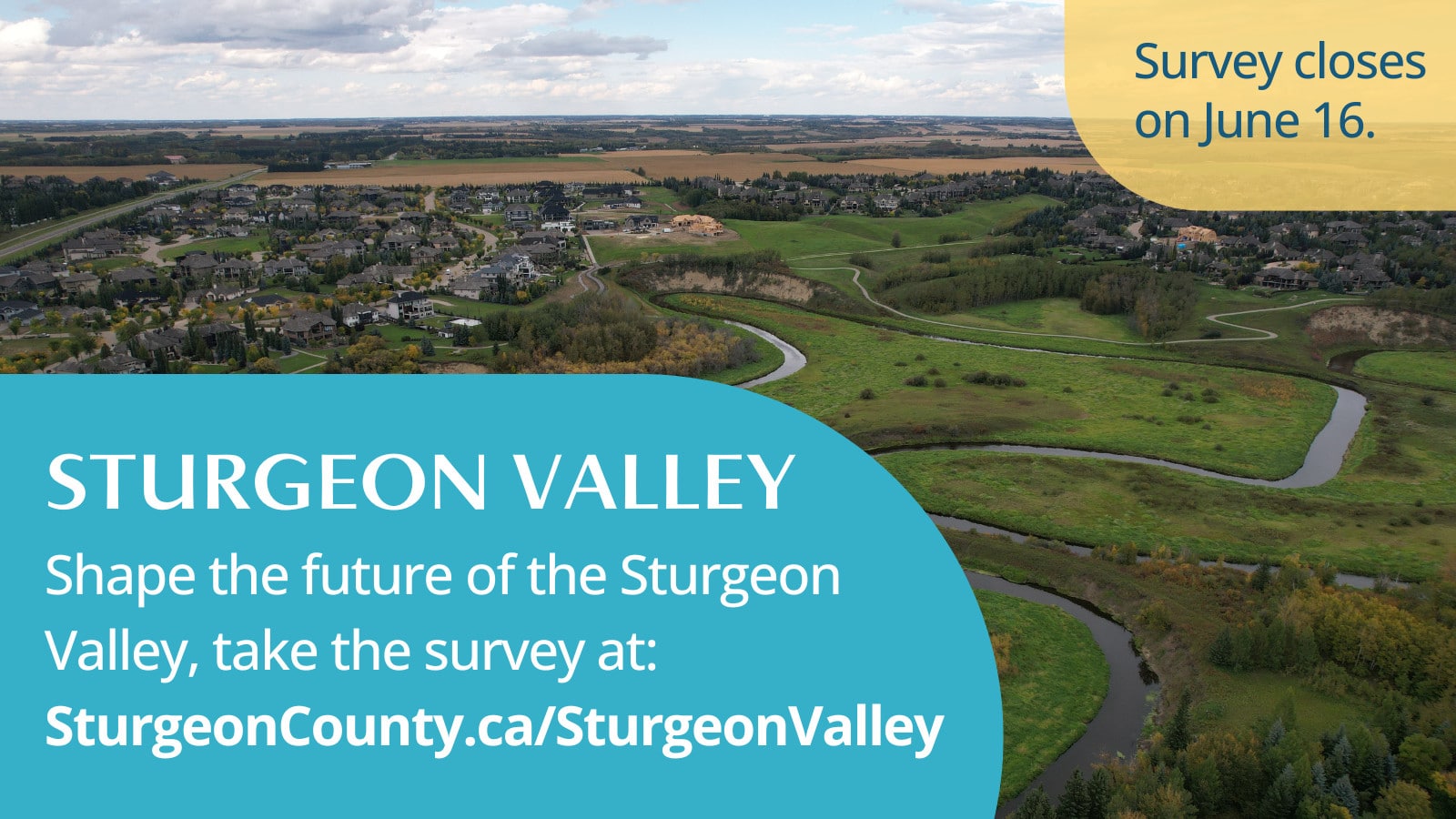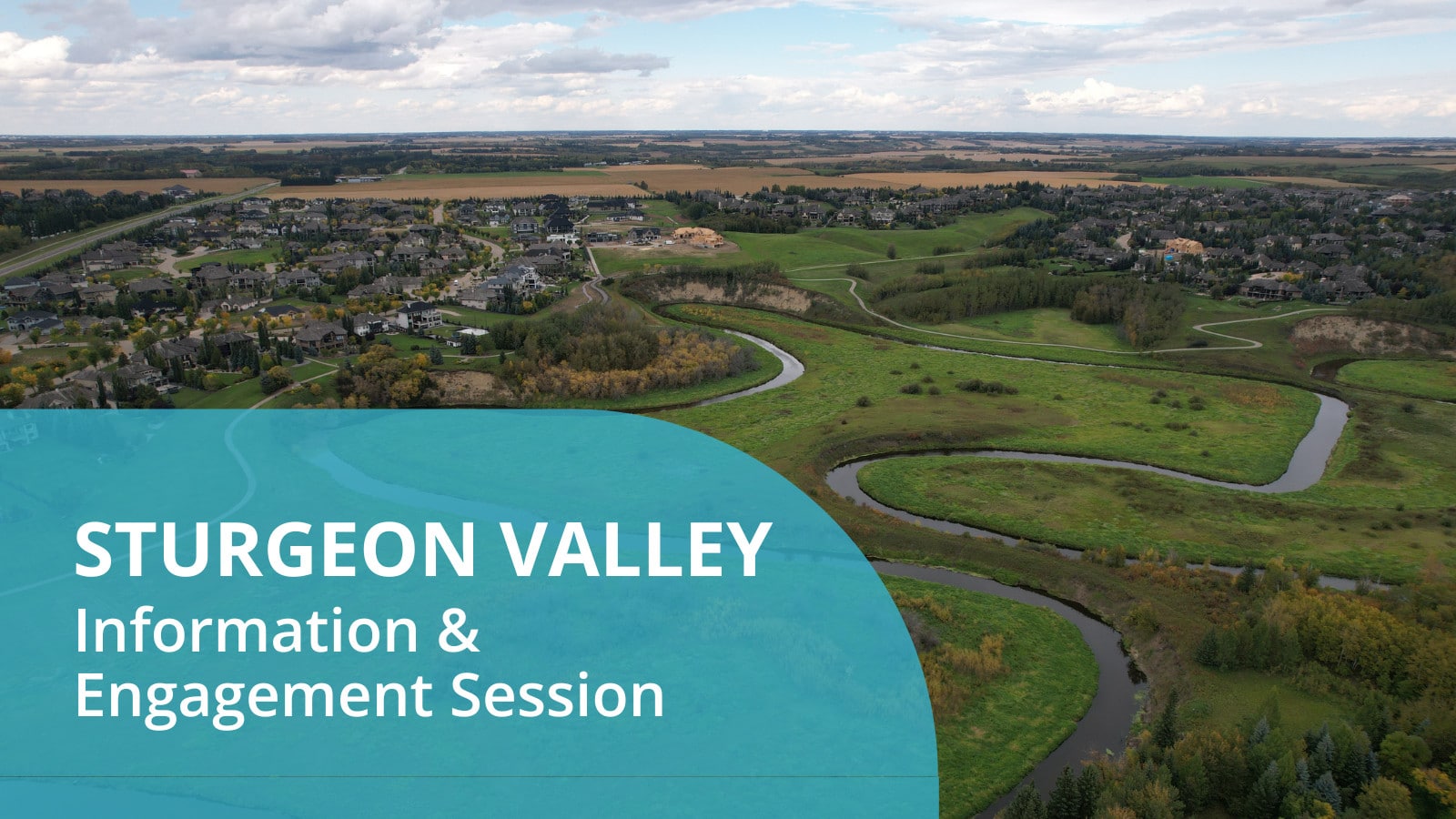What We Heard
Sturgeon County held an information and engagement session on May 30, 2024, and conducted a survey to hear from the public about development in the Sturgeon Valley.
The Sturgeon Valley is a wonderful and unique community in Sturgeon County. It was founded in the 1960s and has grown over decades to have nearly 4,000 current residents in country residential and estate homes.
Sturgeon County has local planning authority for the Sturgeon Valley; however, must follow the provincial Municipal Government Act, other provincial and federal planning and development legislation, and the policies of the Edmonton Metropolitan Region Board.
In 2021 the County approved two area structure plans following extensive public input. Council adopted three bylaws that approved the Sturgeon Valley South Area Structure Plan and the Sturgeon Valley Core Area Structure Plan (near the existing neighbourhoods), and amended the Municipal Development Plan.
Potential 25-year growth scenario
Growth Potential
Most of the County’s future growth is expected to occur in the Valley. The rate of development would depend on market conditions and the interest of local landowners and developers. Current estimates suggest a moderate annual growth rate of 2.1 per cent, which is similar to adjacent communities. Development would occur over several decades and only in defined areas, and would increase dwellings by roughly 150 per year initially, increasing to 300 dwellings per year in later years. View a video showing the potential growth over time.
Lands in the Sturgeon Valley are owned by private landowners who may want to exercise their right to develop their land. The Valley continues to be very desirable for development, due to proximity to regional communities, access to transportation networks, good servicing potential, and abundant natural features.
Through planning for growth in Sturgeon Valley and listening to the community, the County has taken steps to respect the interests of existing residents and neighbourhoods, protect against future annexations, diversify Sturgeon County’s taxation base, and capitalize on the area’s location and existing infrastructure. At the same time, the County is enabling the creation of unique and distinct neighbourhoods that will meet the future needs of local and regional residents.
Some private landowners are now preparing detailed plans for specific neighbourhoods either in the Sturgeon Valley Core or the Sturgeon Valley South. If approved, plans for new neighbourhoods in the Sturgeon Valley South are expected to support:
- New housing options to meet the needs of current and future residents through their different life stages.
- Transitions between existing and new neighbourhoods, to ensure complementary development patterns.
- New parks, trails, and open spaces.
- New small-scale shopping and employment areas.
- New transportation connections, such as a completed 127 Street connecting Sturgeon Road and the Anthony Henday, and other important improvements to minimize traffic.
- New community services, amenities, gathering places, and recreation opportunities.
- Balance and stability in County’s tax base.
Sturgeon Valley South

Sturgeon Valley South could incorporate elements that drive a clean energy economy, reduce our carbon footprint, and protect the natural environment. This community will have trails connecting to parks, abundant natural spaces, and small-scale commercial hubs.
The Sturgeon Valley South would have an average development density of 35 dwelling units per net residential hectare, as required by provincial/regional policy. This means the lots would be smaller than existing residential areas in the Valley and would include a mix of single-detached homes, townhouses, duplexes and multi-unit apartments.
There would be transitions to provide a “buffer” between existing residential communities and more densely populated future neighbourhoods. Closer to existing homes, development densities would be approximately 20 units per net residential hectare. Closer to Edmonton and Anthony Henday Drive, development densities would transition up to 45 units per net residential hectare to mesh with adjacent communities in the City of Edmonton.
Pending approval of private applications and consideration of market conditions, the population of the Sturgeon Valley South could increase by about 2.1% each year (with about 80 dwellings per year initially and increasing to 235 dwellings in later years). Over a 25-year period, the population of the Sturgeon Valley South could increase by up to 8,300 residents.
Overall, the County follows a “growth pays for growth” philosophy, meaning private developers would pay for the infrastructure needed to service these new areas.
Sturgeon Valley Core

Most existing neighbourhoods are in the Sturgeon Valley Core area. Most of this area has been developed at a density of two housing units per net residential hectare and most are large single detached homes. Existing neighbourhoods should expect no change under land use plans.
Development may be considered on vacant lands within the Valley Core. In recent development areas such as River’s Gate, density is closer to 10 housing units per net residential hectare. New neighbourhoods in the Valley Core would have a density of up to 20 dwelling units per net residential hectare. Development would be required to complement existing neighbourhoods and preserve, protect, and enhance the rural and natural landscape as much as possible.
Pending approval of private applications and consideration of market conditions, the population of the Sturgeon Valley Core could increase by about 2.1% each year (with about 65 dwellings per year initially and increasing to 80 dwellings in later years). Over a 25-year period, the population of the Sturgeon Valley Core could increase by up to 5,500 residents.
Overall, the County follows a “growth pays for growth” philosophy, meaning private developers would pay for the infrastructure needed to service these new areas.
What’s Happening Now and How to Get Involved
Opportunities for public input related to the Sturgeon Valley are included below.
Sign up to get Sturgeon Valley news in your inbox
Development Process
- To develop neighbourhoods in the Sturgeon Valley South area, private landowners/developers must create specific neighbourhood area structure plans. These sub-plans must align with the County’s area structure plan and provide general details about the proposed development.
- Development in the Sturgeon Valley Core area does not need a neighbourhood area structure plan, but does need detailed outline plans as noted below.
- Private landowners/developers must hold an open house before submitting their plan to the County for initial feedback on their neighbourhood design.
- Private landowners/developers must submit a “what we heard” report from that pre-application open house alongside their application to the County.
- When private landowners/developers submit plans for new neighbourhoods, the County holds a public hearing to gather input from the public before considering approval. The “what we heard” report from the pre application meeting is included in Council’s agenda package for consideration of the development.
- Public hearings are advertised in local newspapers, posted to the Sturgeon County website and shared on social media. Members of the public are encouraged to participate in public hearings and provide input on specifics of the proposed development.
- Council considers input received at the public hearing when making a decision on whether or not to approve the application. Council must balance public input with the rules and regulations set for developers and EMRB “Special Study Area” requirements.
- If a developer’s neighbourhood area structure plan is approved, developers must create a detailed outline plan for their proposed neighbourhood. These plans detail housing types, road networks, and community trails and parks.
- Developers must hold public engagement sessions about the outline plan before applying to the County for approval
- Council then receives the proposed plan(s) and holds a public hearing to gather input from the public before considering approval. These hearings are advertised in local newspapers, posted to the Sturgeon County website and shared on social media.
- If the above plans are approved, the developers would proceed through consideration of land zoning and subdivision, which prepares the land for individual lot configurations. This process would conclude with development and building permits for specific homes, which new residents could buy.
How We Got Here – The “Our Future Valley” Project
The new vision for the Sturgeon Valley was established in 2021. Council adopted three bylaws following extensive public input. These bylaws approved the Sturgeon Valley South Area Structure Plan and Sturgeon Valley Core Area Structure Plan, and amended the Municipal Development Plan.
The “Our Future Valley” initiative included significant public engagement and communications between November 2020 and April 2021, prior to the adoption of the planning documents.
Background
Since 1999, concepts for new neighbourhoods in the Valley have been developed and considered, and the Alberta government established regional planning authorities (now called the Edmonton Metropolitan Region Board) to guide how this and other regional communities could grow.
In 2017, the Edmonton Metropolitan Region Board designated the Sturgeon Valley as a ‘special study area’ which required Sturgeon County officials at the time to negotiate on specific policies and development densities that would apply to this area. Following the conclusion of regional negotiations and the provincial approval of new rules for the Valley, the County was able to advance its own updated land use plans.
In creating its local area structure plan, the County worked to protect agricultural lands to the north of the existing Valley, confirm land use and infrastructure requirements for the Sturgeon Valley’s vacant lands, guard against annexation interests from communities that may not share the County’s vision, and ensure appropriate ‘buffers’ between new and existing neighbourhoods for quality of life.
Key Dates
Fall 2024
Pending decisions on next steps, potential Council consideration of “Off-Site Levies” for the Sturgeon Valley which apply specific costs to land developers, ensuring ‘growth pays for growth’ in Sturgeon County.
Summer 2024
Expected Council review of updated resident feedback, and decision on next steps for the Sturgeon Valley.
Spring 2024
With developer plans pending for Council consideration, Council supported new resident engagement sessions, the first held in the Sturgeon Valley in May 2024. This was followed by a resident survey, and the preparation of a detailed engagement report. View the presentation delivered on May 30, 2024.
View the What We Heard Report summarizing public input.
View responses to questions asked at the May 30, 2024, information and engagement session.
June 2023 to February 2024
Council approved amendments to technical documents like the Land Use Bylaw and the General Municipal Servicing Standards to reflect the vision and character of the Sturgeon Valley’s potential new neighbourhoods. These amendments are required to give clarity to land developers on specific requirements and costs.
December 2020 to September 2021
Council adopted three bylaws following extensive public input. These bylaws approved the Sturgeon Valley South Area Structure Plan and the Sturgeon Valley Core Area Structure Plan, and amended the Municipal Development Plan.
December 2020 to May 2021
Sturgeon County initiated the Our Future Valley initiative and developed the two Sturgeon Valley area structure plans. This included many opportunities for public input through virtual information and engagement sessions, which were promoted in newspapers, direct mail, road signage, social media, and at public Council meetings. These sessions were held virtually due to the COVID-19 pandemic and public health measures.
2019
The Edmonton Metropolitan Region Board approved policies for the development of the Sturgeon Valley. This decision set the overall densities for undeveloped lands.
2017
The Edmonton Metropolitan Region Growth Plan was updated. It identified the Sturgeon Valley as a “special study area,” which meant the EMRB would determine its future growth once the growth aspirations for the cities of Edmonton and St. Albert had been set.
2013
The Edmonton Metropolitan Region Board identified the Sturgeon Valley as a key strategic area for future regional growth.
2011
The province approved the Capital Region Growth Plan that set limiting development densities for the Sturgeon Valley.
1999
Sturgeon County approved the first Sturgeon Valley Area Structure Plan that allowed for country residential and estate lot developments in the Sturgeon Valley.
1995
The province transferred land use planning authority to municipalities. At this time, 19 Valley neighbourhoods were already approved.
1981
The renamed Edmonton Metropolitan Planning Commission developed the first regional plan that included development policy for the Sturgeon Valley.
1970s
Seven residential subdivisions were approved by the commission.
1963
The Edmonton Regional Planning Commission was established, and was responsible for planning approvals for rural municipalities in the Edmonton region. The first subdivisions of North Point and Sturgeon Heights were approved in the 1960s.
Frequently Asked Questions
Why does Sturgeon County belong to the Edmonton Metropolitan Region Board (EMRB)?
Sturgeon County is legislatively required by the Government of Alberta to belong to the Edmonton Metropolitan Region Board (EMRB). Regional growth management boards were established in the Edmonton and Calgary metropolitan regions to provide integrated and strategic planning for future growth in municipalities. The growth management board creates a growth plan that is reviewed and may be approved by the Minister of Municipal Affairs.
Thereafter, any actions that are not compliant with a Growth Plan may result in written notice from the Board ordering the municipality to stop the action; if the municipality refuses, the Board may seek a court injunction or other order; and the court may grant or refuse the injunction or other order or make any other order it deems is just in the circumstances.
What will the population in the Valley be in the future?
Pending approval of private applications and consideration of market conditions, the population of the Sturgeon Valley South could increase by about 2.1% each year (with about 80 dwellings per year initially and increasing to 235 dwellings in later years). Over a 25-year period, the population of the Sturgeon Valley South could increase by up to 8,300 residents.
Pending approval of private applications and consideration of market conditions, the population of the Sturgeon Valley Core could increase by about 2.1% each year (with about 65 dwellings per year initially and increasing to 80 dwellings in later years). Over a 25-year period, the population of the Sturgeon Valley Core could increase by up to 5,500 residents.
What types of housing or densities can I expect in Sturgeon Valley?
Most of the Sturgeon Valley Core – where existing neighbourhoods are located – has been developed at a density of two housing units per net residential hectare and most are large single detached homes. These existing neighourhoods can expect no change in density or development.
In recent development areas such as River’s Gate, density is closer to 10 to 15 housing units per net residential hectare. Remaining undeveloped areas in the valley core could develop to a maximum of 20 housing units per net residential hectare, subject to servicing availability.
In the Sturgeon Valley South areas (south and east of River’s Gate) the development density would vary with an average of 35 housing units per net residential hectare. There will be transitions to provide a “buffer” between existing residential communities and more densely populated future neighbourhoods. Closer to Edmonton and Anthony Henday Drive, development densities will transition up to 45 units per net residential hectare. This aligns with the requirements of the Edmonton Metropolitan Region Growth Plan, which Sturgeon County must conform to.
Development speed is dependent on market conditions and the investment interest of local landowners and developers. Sturgeon County expects development to occur over decades. Residents will be engaged throughout that process.
What changes can I expect as someone living in an existing neighbourhood?
If you already live in the Sturgeon Valley, you can expect no change, or very little change aside from road improvements, more trails and access to greenspaces. Those living closest to any new development areas could notice some change during and after construction, but for the most part, development near you will look very similar to what you already know.
How will new development be kept consistent with existing development when there is an increase in density?
Densities in the Sturgeon Valley Core are mandated by the Edmonton Metropolitan Region Board (EMRB) Growth Plan to be a maximum of 20 dwelling units per net residential hectare; however, proposed developments may consider densities from one to 20 dwelling units per net residential hectare. New development in the Sturgeon Valley Core must complement existing neighbourhoods and preserve, protect, and enhance the rural and natural landscape as much as possible.
One way this will be done is through transitional densities or buffers between existing and new neighbourhoods. When a new neighbourhood is proposed directly adjacent to an existing neighbourhood, the homes directly adjacent to existing homes must be built at the same density. This means that the home immediately behind or beside you will look very similar to your property. Across the street and where lots do not back directly on to adjacent existing neighbourhoods, the lots could be smaller from those new homes on larger lots.
Development Process
- Private landowners/developers must hold an open house before submitting their plan to the County for initial feedback on their neighbourhood design.
- Private landowners/developers must submit a “what we heard” report from that pre-application open house alongside their application to the County.
- When private landowners/developers submit plans for new neighbourhoods, the County holds a public hearing to gather input from the public before considering approval. The “what we heard” report from the pre application meeting is included in Council’s agenda package for consideration of the development.
- Public hearings are advertised in local newspapers, posted to the Sturgeon County website and shared on social media. Members of the public are encouraged to participate in public hearings and provide input on specifics of the proposed development.
- Council considers input received at the public hearing when making a decision on whether or not to approve the application. Council must balance public input with the rules and regulations set for developers and EMRB “Special Study Area” requirements.
Why is growth planned for the Sturgeon Valley instead of existing urban areas?
The Sturgeon Valley has been growing over more than 60 years. Land in the Sturgeon Valley Core and Sturgeon Valley South is owned by private landowners, and some want to develop their land for residential subdivisions. The Valley continues to be very desirable for residential development, due to convenient access to neighbouring cities for employment and access to a range of services, while enjoying the country lifestyle. Many people moving to or within the Edmonton region prefer the choices of what the Valley has to offer, compared to other communities such as Morinville, Gibbons or Bon Accord.
Undeveloped lands are more likely than developed lands to be annexed by another municipality. The Sturgeon Valley is surrounded by expanding cities, whereby urban municipalities in Alberta typically choose to annex rural municipality lands for several key reasons:
- Annexation allows urban municipalities to expand their boundaries to accommodate development when they run out of available land within their existing borders.
- Annexations typically happen at the fringes of urban municipalities, allowing cities to:
- support industrial or commercial development, potentially increasing urban municipality tax base,
- plan for long-term expansion including transportation networks and infrastructure servicing.
Sturgeon County believes in the importance of guiding the Sturgeon Valley’s growth itself rather than risk losing that authority to another municipality in the future.
How are residents notified of proposed developments?
Private landowners/developers must develop detailed outline plans for new neighbourhoods in the Sturgeon Valley Core. These plans detail housing types, road networks, and community trails and parks. Developers must hold public engagement sessions about the outline plan before applying to the County for approval. Typically, these are promoted in the newspaper and via mail.
The County holds a public hearing to gather input from the public before considering approval. These hearings are advertised in local newspapers, posted to the Sturgeon County website and shared on social media. Members of the public are encouraged to participate in public hearings and provide input on specifics of the proposed development. In making its decision, Council must consider public input as well as the rules and regulations set for developers through the Municipal Government Act, the Growth Plan and area structure plans.
How can I share my thoughts about developments in the Sturgeon Valley?
To develop neighbourhoods in the Sturgeon Valley South area, landowners must create specific neighbourhood area structure plans. These are sub-plans that support the area structure plan and provide general details about the development, including density. Landowners must hold public engagement sessions about the plan before applying to the County for approval. These plans need Council approval. Council holds a public hearing to gather input from the public before considering approval. These hearings are advertised in local newspapers, posted to the Sturgeon County website and shared on social media.
Development in the Sturgeon Valley Core area does not need a neighbourhood area structure plan. If approved, landowners must create outline plans. These neighbourhood-level plans detail housing types, road networks, community trails, and parks. Landowners must hold public engagement sessions about the outline plan before applying to the County for approval. These plans need Council approval. Council holds a public hearing to gather input from the public before considering approval. These hearings are advertised in local newspapers, posted to the Sturgeon County website and shared on social media.
How does this impact agricultural land?
The Edmonton Metropolitan Region Board (EMRB) designated the Sturgeon Valley as a ‘special study area’ which meant Sturgeon County officials had to negotiate on specific policies and development densities.
All undeveloped lands in the Sturgeon Valley (Core and South) are currently zoned as AG- Agriculture. Developers, at the time they want to develop, must apply to have the lands rezoned.
When the Valley Core Area Structure Plan was approved, there was a 42 per cent reduction in the amount of land identified for future development. Council conserved this large area of land for agriculture. Sturgeon County remains firmly committed to supporting and growing agriculture, agribusiness and agritourism.
How will development impact assessment and taxes?
The presence of higher-density homes does not automatically increase or decrease the value or taxes of surrounding country residential properties. Property assessment is based on the market value of the land, and municipal taxes are levied based on a property’s proportional share of assessment.
Is undeveloped land more likely to be annexed?
Undeveloped lands are more likely than developed lands to be annexed by another municipality. The Sturgeon Valley is surrounded by expanding cities, so Sturgeon County chose to guide the Sturgeon Valley’s growth itself rather than risk losing that authority in the future. Sturgeon County’s growth, like other municipalities in the region, is bound by provincial and regional land use policies.
Will there be any more Country Residential Estate zoning in Sturgeon County in the future?
The Edmonton Metropolitan Region Board (EMRB) designated the Sturgeon Valley as a ‘special study area’ which meant Sturgeon County officials had to negotiate on specific policies and development densities. Densities were set at up to 20 dwelling units per net residential hectare for the Sturgeon Valley Core and an average of 35 dwelling units per net residential hectare for the Sturgeon Valley South. In general, new country residential developments are not supported in the Edmonton Metropolitan Region.






